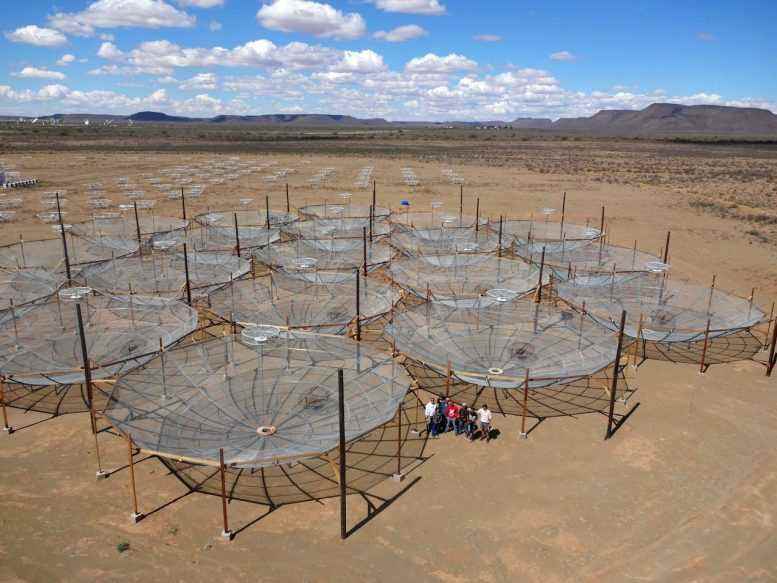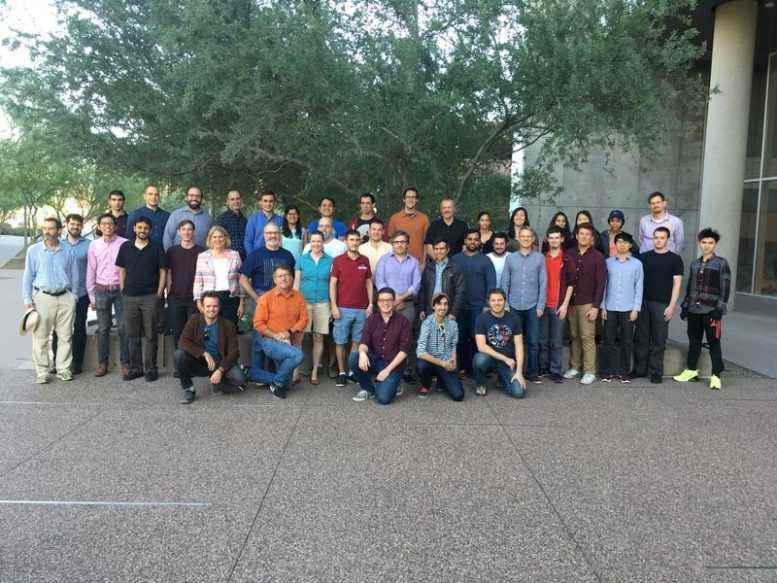İle
Bilim adamları dahil[{” attribute=””>MIT’s Jacqueline Hewitt and Nicholas Kern share long-awaited results, getting closer to the universe’s first stars.
All through history, humans have created and shared stories that ponder the creation of stars — what they are and how the first stars came to be. Now, with new results from the Hydrogen Epoch of Reionization Array (HERA), a radio telescope located at the South Africa Karoo Astronomy Reserve, MIT scientists are one small, but significant, step closer to understanding that history.
HERA researchers are looking for the earliest signs of star formation and galaxy structure. Specifically, scientists including Jacqueline Hewitt, the Julius A. Stratton Professor of Physics at MIT, are trying to understand what happened during a period called the cosmic dawn, which occurred about 400 million years after the Big Bang. In early fall 2021, Hewitt, Nicholas Kern, a Pappalardo Fellow in Physics at the MIT Kavli Institute for Astrophysics and Space Research, and other researchers from the international collaboration finalized the long-awaited results collected and analyzed over four years, during the first stages of the telescope’s construction.
Their study, published on February 7, 2022, in the Astrophysical Journal, presents new upper limits on radio signals from cosmic hydrogen, which indicates early star formation and gives scientists a clearer picture of when the first stars and galaxies formed. These findings narrow down the theoretical models that hypothesize on the origins of the cosmic dawn.

Part of the HERA radio interferometric array in the South African Karoo desert during early construction in 2016, pictured with site crew for scale. Credit: Kathryn Rosie
The HERA findings are in part so significant because they were collected at such an early stage in HERA’s development. The telescope, which operates as an array of radio dishes, currently sits at just a fraction of its ultimate size — the data were collected from just 39 of HERA’s 52 deployed antennae. In its full form, there will be 350 total antennae. Once fully constructed, HERA will be sensitive enough to gather even larger datasets and information from further away, and thus further back in time.
“We’re not yet doing fully what we can do,” says Kern, the paper’s lead author. “This result is a demonstration of the telescope as an entity. It’s a demonstration of a first pass at an analysis of the data, which is kind of a framework, a bedrock, if you will, going forward for all future analysis.”
Seeking a signal
To look back at the cosmic dawn, HERA uses low-frequency radio waves to identify signals that are not easily observed. This is different from other telescopes, such as the Hubble Space Telescope, which observe structures like galaxies that comprise just 5 percent of the observable matter in space. The other 95 percent of matter is what is between galaxies, including low-density hydrogen. With HERA, scientists can look at what is going on between galaxies and use that information to infer what galaxies are doing that we cannot observe, and how galaxy formation influences the space around it.

Members of the HERA collaboration at a science meeting. The HERA team consists of institutions across the U.S., Canada, Europe, and South Africa. Credit: Photo courtesy of the HERA team.
To understand this period in the universe’s history, scientists are looking for the “spin flip signal,” also known as the 21-centimeter line, which is the wavelength of neutral hydrogen gas. This radio signal comes from intergalactic material between galaxies and is produced by the emission and/or absorption of hydrogen atoms given off through this transition.
“What we’re looking at with HERA is: What does the spin flip signal look like during this era?” says Steve Furlanetto, the HERA project’s lead theorist and an associate professor of physics and astronomy at the University of California at Los Angeles.
Identifying the Epoch of Reionization, or the timing of when the signal is observed, is what’s important, he says. “We want to know if [the signal] absorpsiyondadır, yani X-ışınlarından önce veya X-ışınlarından sonra olan emisyondadır. Ve sonra yeniden iyonlaşma nedeniyle ortadan kaybolup kaybolmadığını görmek istiyoruz.”
Sinyalin yakalanabilen iki imzası veya işlemi vardır. Sinyal ilk olarak yıldızlar hidrojen gazını ısıttığında değişir. HERA’nın şu ana kadar aradığı ikinci kısım, ek yıldız oluşumunun ürettiği enerji ile hidrojenin iyonlaşması sırasında meydana gelen 21 cm’lik sinyalin kaybolmasıdır. Bu imza, yıldızların yaratıldığını gösterir.
Kozmik şafaktan 21 cm’lik çizgi henüz kesin olarak tespit edilmedi. Bununla birlikte, HERA’dan elde edilen yeni sonuçlar, evrenin 500 milyon yaşında olduğu zamana ait döndürme sinyalinin doğası hakkında – önceki sonuçlardan 10 kat daha hassas – veriler sağlar.
ilk bakış
Bu sonuçlarla HERA ekibi, galaksi oluşumuyla ilgili birkaç olası teoriyi dışlayan kanıtlar sunmayı başardı. En önemlisi, veriler, uzayda hidrojeni ısıtmak için bir mekanizma olması gerektiğini gösteriyor, bu da galaksilerin kara deliklere sahip olması gerektiği anlamına geliyor.

HERA’nın bir parçası mı? Güney Afrika, Karoo çölünde radyo interferometrik dizi. Kredi bilgileri: Dara Storer
Furnaletto, “Kara delikleri olmayan galaksileriniz varsa, bu temelde göz ardı edebileceğiniz bir şey” diyor. “Bu modeller bağlamında, X-ışınlarının üretildiği kara deliklerin olması gerektiği anlamına gelen bir ısıtma olmalı.”
Gordon ve Betty Moore Vakfı ve Ulusal Bilim Vakfı’nın finansmanıyla HERA, 350 antende çalışacak ve teleskopun daha düşük frekanslı radyo dalgalarını yakalamasını ve daha yüksek kırmızıya kaymalarda görüş noktalarını etkin bir şekilde görmesini sağlayacak yeni bir anten tasarımıyla çalışacak. zaman.
HERA’nın sinyal kapasitesini genişletme proje lideri Hewitt, 2004’ten beri en erken yıldızların ne zaman oluştuğu sorusu üzerinde çalışıyor. Yeni düşük frekans bileşenlerinin prototiplenmesine öncülük ediyor ve mevcut ve gelecekteki veri kümelerini analiz etmek için daha fazla teknik geliştiriyor. . Cambridge Üniversitesi’nden alınan yeni anten tasarımı, 2022’nin başlarında kurulmalı ve elde edebilecekleri bilgi aralığını önemli ölçüde artıracak.
Hewitt, artan menzilin kozmik tarihin erken aşamaları hakkında daha fazla şey öğrenmelerine yardımcı olacağını açıklayarak, “Düşük frekanslara yapılan bu genişleme, bizi ilk yıldızlardan önceki bu döneme götürdüğü için önemli” diyor.
“Nasıl çalıştığı şaşırtıcı. Biraz yoruluyorsun ama bazen durup ’13 milyar yıl geriye bakan bir enstrüman yapıyorum’ diye düşünüyorum, anlıyor musun?” dedi Hewitt. “Bunu gerçekten yapabilmemiz inanılmaz.”
Referans: “HEA Aşama I’den İlk Sonuçlar: Reionization Epoch of Reionization 21 cm Güç Spektrumu Üst Sınırları” Zara Abdurashidova, James E. Aguirre, Paul Alexander, Zaki S. Ali, Yanga Balfour, Adam P. Beardsley, Gianni Bernardi, Tashalee S. Billings, Judd D. Bowman, Richard F. Bradley, Philip Bull, Jacob Burba, Steve Carey, Chris L. Carilli, Carina Cheng, David R. DeBoer, Matt Dexter, Eloy de Lera Acedo, Taylor Dibblee-Barkman, Joshua S. Dillon, John Ely, Aaron Ewall-Wice, Nicolas Fagnoni, Randall Fritz, Steven R. Furlanetto, Kingsley Gale-Sides, Brian Glendenning, Deepthi Gorthi, Bradley Greig, Jasper Grobbelaar, Ziyaad Halday, Bryna J. Hazelton, Jacqueline N. Hewitt, Jack Hickish, Daniel C. Jacobs, Austin Julius, Nicholas S. Kern, Joshua Kerrigan, Piyanat Kittiwisit, Saul A. Kohn, Matthew Kolopanis, Adam Lanman, Paul La Plante, Telalo Lekalake, David Lewis, Adrian Liu, David MacMahon, Lourence Malan, Cresshim Malgas, Matthys Maree, Zachary E. Martinot, Eunice Matsetela, Andrei Mesin ger, Mathakane Molewa, Miguel F. Morales, Tshegofalang Mosiane, Steven G. Murray, Abraham R. Neben, Bojan Nikolic, Chuneeta D. Nunhokee, Aaron R. Parsons, Nipanjana Patra, Robert Pascua, Samantha Pieterse, Jonathan C. Pober, Nima Razavi-Ghods, Jon Ringuette, James Robnett, Kathryn Rosie, Peter Sims, Saurabh Singh, Craig Smith, Angelo Syce, Nithyanandan Thyagarajan, Peter KG Williams, Haoxuan Zheng ve HERA İşbirliği, 7 Şubat 2022, Astrofizik Dergisi.
DOI: 10.3847/1538-4357/ac1c78
Bu çalışma, kısmen, HERA işbirliği ortaklarının kurumsal desteğiyle Ulusal Bilim Vakfı ve Gordon ve Betty Moore Vakfı tarafından desteklenmektedir. HERA, Bilim ve Yenilik Departmanı’nın bir ajansı olan Ulusal Araştırma Vakfı’nın bir tesisi olan Güney Afrika Radyo Astronomi Gözlemevi tarafından barındırılmaktadır.

